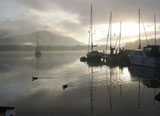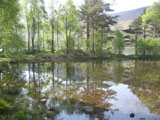|
|
Lake District Mountain and Fell Walks 16
Hallinfell and Martindale - 3 milesHallin Fell summit offers one of the National Park's greatest views. One can look over Ullswater, and on very clear days away north into Scotland. It stands beside the high entrance into the unspoilt valley of Martindale with its ancient and very simple little chapel. The walk described visits the viewpoint and the chapel. As it is a figure-of-eight walk with the car in the middle, it can be divided into two short walks. From the hamlet of Pooley Bridge take the Penrith road for a short distance, then take the first turning right, and the first turning right again for Howtown. Howtown is reached after four miles along this narrow road. It is not a town by any stretch of the imagination and when you reach the cattle grid you have passed it. Go on up the very steep hill with hairpins - first gear may be required. Go right to the top of the hill and you will find room to park near the church. The path starts up the grassy slope opposite the drive to the church. Go upwards to the wall and follow it right. At the path fork continue left to follow the wall up steep grass. At the wall corner continue on. There is a pile of stones on the right with a fork right. Continue on upwards on the broad grassy track. Pausing for breath and looking left you see the two valleys: Martindale on the left leading upwards to Bannerdale and the deer forest; and Boredale on the right. They were both scooped out by glaciers in the ice age from Place Fell. Red deer might be seen with binoculars, particularly in winter. There are also half-wild fell ponies in the area. Notice how the valley bottoms are green and lush in contrast to the bracken and heather covered slopes around. Take your time and you will eventually approach the summit, the wide grassy track narrowing a little. Ahead there is a little hause. A hause is the Lake District name for a saddle, or a pass, or a depression in a hill summit. Through this little hause is a grassy platform. Cross it bearing right and climb a little and you will see a stone cairn, square-shaped, on the summit. As you reach it the views burst upon you - a dramatic revelation! Across the lake way over on the left you see the Helvellyn range, with the pointed peak of Catstye Cam 101 feet short of Helvellyn's 3,118. Prominent on the right of the long Helvellyn ridge are the mountains of Blencathra; and beyond it Skiddaw which overlooks Keswick. You can wander about this open summit to pick up various viewpoints. For instance if you walk back to the grass platform near the hause again, but this time turn right to descend by a natural hollow you will presently come to an edge with an airy view down to the lake over the little hamlet of Sandwick. Retrace your steps to the summit cairn. With your back to the lake and looking east and south there is the long ridge of High Street. "Street" suggests a roman road. In fact a roman road ran right along that summit ridge, largely following an ancient British road. Why along such a high ridge? In ancient times the whole of the valleys were covered in dense forest and scrub and swamp, inhabited by the wild red deer which still roam the area, and which did so long before man came on the scene at all. It was much easier to walk, or ride, along this straight ridge. To descend leave the cairn north-eastwards towards the foot of the lake (Pooley Bridge). Follow the grassy path which divides temporarily into two going in the same. direction. A cairn appears on the left which is another viewpoint. Continue on the grassy path taking care on the steepness. The path levels off and curves right. Continuing on there is a level with a steep slope left to the lake. A path joins from the left by a wet area which might be a small tarn after rain. Continue on and there is a cairn on a little hill in front. The now broad green path goes to the right of this but a digression to the cairn is worthwhile. From the cairn walk towards the lake along the little ridge then right the few yards to the next cairn which offers views down towards Howtown and the steamer pier. Turn sharp right to follow the path back towards the wide grassy path you just left. Continue left, down it, when you rejoin. The church appears below and the path steepens. Turn right by a cairn, and at the fork ~urn right on the easier route. You rejoin the path by which you ascended, at the wall corner. Descend by the wall to the starting point. Walk past the church gate and follow the wall on the right to pick up a track by a little tarn. Go to the right of the tarn still following the wall. Follow the wall right round the corner past (not through) the gate, and on. (The path above on the fell side cuts the corner but the way is rather rough). At the top of the hill follow the path by the wall side again. As you go forward Martindale is seen below you with its pretty arch bridge and its chapel, looking from this angle like an old barn, partly obscured by a crag. The narrow path moves away from the wall as it cuts a corner. The wall side is joined again further on. Now follow the wall round and down towards the little chapel, picking up the path which zig-zags down to avoid the steepness. The interior of the church is starkly simple and moving. This is the place where simple people worshipped and there are no elaborate memorials and stone effigies of knights. The existing walls were built in 1633 but they were built on foundations that already existed and there has been a chapel here for many centuries. The old square holy-water stoup is reckoned to be 14th century. On it are the marks of arrow-sharpening activity. Some restoration work was done in 1880 when the new church, at the head of the hause, was built. In the churchyard there is a very old yew tree, itself several centuries old. They were said to be planted to supply wood for long-bows. But the evergreen yew was also planted in churchyards as symbols of everlasting life. Yew trees can live on for many many centuries. The sticky berries are much enjoyed by birds but are poisonous to humans. The foliage, when cut and partly withered, is dangerous to cattle. On leaving the church turn right and follow the road. There is a fine sycamore on the left. At the road junction walk right on. The old school is down on the left. Follow the road up to your starting point. Copyright Mary Welsh, © 2008. All rights reserved. No reproduction without permission. |
|


